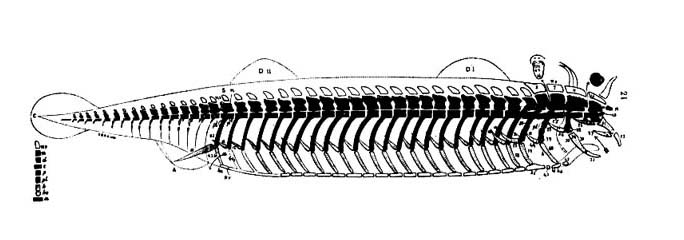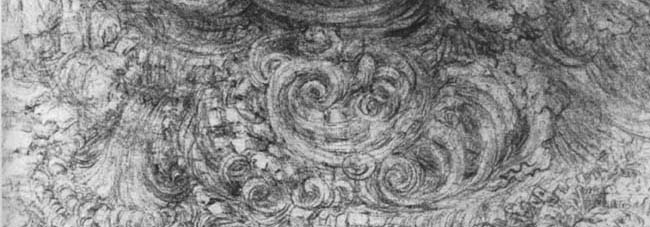Phase space: (or state space) Allows representation of the behaviour of a system in geometric form. The number of dimensions required for the phase space is a function of the "degrees of freedom" of the system.
A dynamical system consists in two parts: the notions of a state (the essential information about a system) and a dynamic (a rule that describes how the state evolves with time). This evolution can be visualized in a phase space. Phase spaces can have any number of dimensions, corresponding to the “degrees of freedom” of the system. The figures drawn in the phase space that describe the system's behavior are phase portraits.
abstraction
Singularity
A singularity is a kind of discontinuity. It might or might not be interesting. A vaguer use of the term is simply "a point where something happens" (although this equally describes an event.) Deleuze and Guattari are fascinated by singularities because they are points of unpredictability, even when deterministic. They are thus the sites of revolutionary potential.
As used by mathematical physicists, a singularity means a place where slopes become infinite, where the rate of change of one variable with another exceeds all bounds, and where a big change in an observable is caused by an arbitrarily small change in something else. (cf sensitivity to initial conditions). It is an actual point of infinite density and energy that's kind of a rupture in the fabric of space-time.
Astrophysics describe the centers of black holes as singularities.The Big Bang is considered to be a singularity.
A phase singularity is a point at which phase is ambiguous and near which phase takes on all values. Time at the poles of the earth is an example.
Theory
"It is the theory that decides what we can observe." (Einstein)
"It is more important that a theory be beautiful than it be true." (Paul Dirac)
In Greek, theoria originally meant a looking at or viewing and theoreo, a spectator. In this sense, theory and Visuality are metaphors of each other.
Is the theoretical attitude is that of the disengaged observer? Does theory require a distinction between the illusionless observer and the gullible participant, or to put it more mildly, between theory and observation? Does theory always entail what John Dewey derided as the "spectator theory of knowledge"? Perhaps to theorize is to create the impression of something that existed already (or, even better, always already) (see metaphor) In the Pragmatic tradition, theory is the critical reflection on "belief." William James calls it "an appetite of the mind," what Frank Lentricchia calls "the need to generalize" and "to obliterate differences." (quoted in Cary Wolfe, Postmodern Theory and the Pragmatics of the "Outside" )
But according to the Greek conception, theory is not a knowledge but touching (thigein ).
Read Moreabstract/concrete
The etymological origins of "abstract" are the latin abs trahere , to draw away from. Thus the abstract is separated from body, object, or application. It can describe qualities apart from any object or thing. In Archaic Greek art, the genre of particular things outweighed their specific, individual qualities in artistic representation. Hence abstraction, expressed through the geometricization of natural forms, dominated Archaic art. A Greek polis , when understood as a particular pattern of life and not just a geographical grouping of people and their belongings, was essentially an abstract conception, just as a nation "is today. (see J.J. Pollitt, Art and Experience in Classical Greece.) When we describe a culture in terms of categories such as "religious," "economic," etc. we are not describing real subdivisions, but are making abstractions for our convenience. In the study of "structures" the practice of analysis consists in constructing "models" that replace the study of concrete phenomena by that of an object shaped through its definition.
Read MoreAnalogy/Homology

The concept of homology, or morphological correspondence, was the central tenet of philosophical anatomy. It was used to define structural similarity. Homologies, which are now defined in terms of evolution, were formerly interpreted in a transcendental sense. Whereas homologous parts are now considered to have descended from a common ancestor, in the pre-Darwinian era they were usually looked upon as evidence of an ideal pattern imposed on nature, or a blueprint in the mind of the creator.
Read MoreAttractors
Attractors are geometric forms that characterize long-term behaviour in the phase space. Roughly speaking, an attractor is what the behaviour of a systems settles down to, or is attracted to. They are globally stable in the sense that the system will return if perturbed off the attractor, as long as it remains within the basin of attraction.
Read MoreAutopoesis
Autopoesis is both a concept about self-maintaining systems, especially biological ones, and an epistemological theory about cognition and self-reference.
Read Morebachelor machine

The term "bachelor machine" was first used by Marcel Duchamp around 1913 in connection with pieces of work that would later be assembled in the Large Glass of 1915-1923. (Also known as the bride stripped bare by her bachelors, even) For Duchamp, the term refers specifically to the lower portion of the glass, the realm of the bachelors, which contains, among other things, the chocolate grinder, the cemetary for uniforms and liveries -- Priest, Delivery Man, Gendarme, Cuirassier, Policeman, Pallbearer, Footman, Stationmaster and Page Boy -- and the témoins oculistes. The Large glass consists of two distinct realms, the realm of the bride above, and the realm of the bachelors below, both desiring and imagining one another without any possibility of mutual comprehension. (one is here reminded of the real / imaginary distinction and the discussion of cyberspace)
Read Morebeing / becoming
For Cassirer, " Form thinking" belongs to being, while "causal thinking" belongs to becoming. But strict knowledge is only possible of the always-being. That which is becoming can only be described, if at all, in the language of myth. Or rather, myth is already familiar with both the question of the "what" and the question of the "whence." "It sees everything that it grasps (the world as well as the gods) under this double aspect." (The Problem of Form and the Problem of Cause, in The Logic of the Cultural Sciences, p. 87)
Read Morebifurcation
A bifurcation occurs when an attractor changes qualitatively with the smooth variation of a control parameter. Physically, bifurcations denote phase transitions from a state of equilibrium to new possible states of equilibria. (see also singularities)
Read MoreConsumerism
"When the going gets tough, the tough go shopping."
Consumerism is an acceptance of consumption as a way to self-development, self-realization, and self-fulfillment. It makes a clear separation between producers and consumers. In a consumer society an individual's identity is tied to what s/he consumes. People living in consumer cultures have a tendency to satisfy social, emotional, and spiritual needs with material things.
For critics of consumerism, such as Zygmunt Bauman (Consuming Life), “the consumerist society has to rely on excess and waste” (p.38) The advent of consumerism augurs the era of ‘inbuilt obsolescence” and the insatiability of needs. New needs need new commodities; new commodities need new needs and desires, and this dynamic makes individuals wish to do what is needed for the to enable the system to reproduce itself. Thus consumption is a “hedonic treadmill” (p.45). Its promises of satisfaction remain seductive only as long as the desire stays ungratified.
Read Morefold
"In the late work of the painter is the fold / of that which comes to presence and of presence itself / become simple, 'realized.' healed, / transfigured in an identity full of mystery. / Does a path open up here, that leads to the co- / belonging of poetry and thought?" From Martin Heidegger, "Cezanne." in Gedaches, quoted in Agamben, Stanzas, p 158, n.)
"A structure is a regularized infolding of an aleatory outside." (Brian Massumi, p. 58) (see inside / outside ) For Gilles Deleuze, the Baroque is an operative function endlessly producing folds. These operations occur on two levels: the pleats of matter and the folds of the soul. What is the connection between the two? Correspondence, communication, or a fold between two folds?
form
Is there an independent problem of form, for which biology must develop its own concepts and methods of thought? The Pre-Darwinian project of rational morphology was to discover the "laws of form," some inherent necessity in the laws which governed morphological process. It sought to construct what was typical in the varieties of form into a system which should not be merely historically determined, but which should be intelligible from a higher and more rational standpoint. (Hans Driesch, 1914, p. 149)
Read Morefractals

The classic example used by Benoit Mandelbrot to introduce the fractal geometry of Nature is the question: How long is the coastline of Britain? Imagine measuring the coastline with a meter-long stick. This act of measurement would make an approximation of the coastline consisting of a finite number of meter-long straight lines and would give us one result. If we went back with a 50cm long stick and remeasured, we would get a total more than twice the first. As our unit of measure became smaller, the total length would increase without bounds. Our answer to the question would be that the length is scale dependent and increases without bound as the scalar unit becomes smaller. However, the "roughness" of the coastline seems to remain constant at every scale. Fractals have the same degree of irregularity at all scales of measurement. This roughness can be calculated as the log-log plot between the measured length and the reciprocal of the measuring unit, between "count" and "step" (see fractal dimension)
Read MoreGestalt
The word "Gestalt" is usually translated as form, although it might be better understoond as "organized structure," as opposed to "heap", aggregate, or simple summation (what Max Wertheimer called "and-sums.")
Read Morehypertext city

As a conceptual framework, Hypertext provides a specific means of configuring issues sourrounding the confrontation of cyberspace and the city. It does so by embracing the advent of the electronic realm and the proliferation of networked links while at the same time interpreting these technological transformations as part of the project of writing. More specifically, studies of hypertext have focussed on the history of writing as technology, on the potential for hypertext to change the relationships between reading and writing, to alter the demarcations between the inside and outside of the text, and to change the nature and role of narrative. For its proponents, hypertext is the mode of writing that articulates the sociality of the network, that promises democratization and the empowerment of the individual, and that rearticulates themes that writing and the city have been seen to share: in the construction of memory, in the relation between movement and the subject, and in the production of space through abstraction and narrative.
Read Morelogical type
"This statement is a lie." true or false?
Bertrand Russell' s theory of logical types arose in the early part of the twentieth century as a result of contradictions and paradoxes in the mathematical theory of infinite sets. For example, "the class of all those classes that are not members of themselves" was self-contradictory. One such contradictory entity within mathematics endangered the self-consistency of all mathematics, so that Russell came to the conclusion that all such paradoxical statements had to be ruled out. He devised a hierarchical "theory of types" in which the legitimate members of a set at one level all belong to the level just below.
mapping
A "map" takes points in one space (the source space) to certain points which the map identifies as the "corresponding points" in another space (the target space). Wittgenstein calls these "logical spaces." Symbolic structures which obey a system of rules for translation are isomorphisms, structural homologies. Thus the mapping amounts to a distorted image of the source space on the target space. Language maps thought on to sound. An input/output function can be understood as a mapping. Thus the toaster executes a function mapping from bread to toast, and the groove on a gramophone record maps to the sounds. The psycho-physiological problem in mechanistic psychology becomes a problem of point-to-point mapping of mental functions such as language and memory on to the brain. (see mind /brain )
Read MoreMandlebrot set

The Mandlebrot set has been described as the "most complicated object in the world." The figure represents the boundary of the domain of attraction of the behaviour of a simple equation in the complex plane. It is not the domain of attraction of a single system but rather a map of a family of systems, based on a single criterion.
Read Moremorphospace
The theory of what Stephen Jay Gould has called morphospace is that space of possible morphologies for species organized according to certain principles. Proponents of robust morphogentic processes, such as Stuart Kaufman or Richard Goodwin, see these processes as having large basins of attraction in morphospace.
Read More